Issue 18. 16 November 2009.pdf - UWA Staff - The University of ...
Issue 18. 16 November 2009.pdf - UWA Staff - The University of ...
Issue 18. 16 November 2009.pdf - UWA Staff - The University of ...
You also want an ePaper? Increase the reach of your titles
YUMPU automatically turns print PDFs into web optimized ePapers that Google loves.
SERPENT probes the deep<br />
continued from page 1<br />
Existing iNdustrial Technology. In<br />
Australia, the project is dubbed SEA<br />
SERPENT (for South East Asia) and the<br />
Chief Investigator at <strong>UWA</strong> is Winthrop<br />
Pr<strong>of</strong>essor Chari Pattiaratchi from the<br />
School <strong>of</strong> Environmental Systems<br />
Engineering.<br />
While his project colleagues are<br />
discovering some weird and wonderful<br />
creatures that inhabit the deep water,<br />
Pr<strong>of</strong>essor Pattiaratchi looks at the<br />
physical side <strong>of</strong> drilling in this<br />
environment.<br />
“We are studying the water column<br />
structure (changes in temperature,<br />
salinity and oxygen content) and the<br />
seabed (looking at the current and<br />
sediment transport),” he said.<br />
“When companies drill through the<br />
earth under the sea, whether it’s for<br />
exploration or production, they discharge<br />
back into the ocean whatever they drill<br />
out. It is not just earth, because they use<br />
chemicals for lubricants and in cooling<br />
the drills.<br />
“We want to find out what the impact <strong>of</strong><br />
this ‘drill spoil’ is on species which live in<br />
the deep waters. How far does it move?<br />
Does it move once it has settled on the<br />
sea bed?<br />
“This is quite a new phenomenon<br />
because <strong>of</strong> the depth. In shallower water,<br />
strong currents will disperse the drill spoil<br />
quickly and it will have little effect. But<br />
we don’t know what happens at greater<br />
depths.”<br />
SEA SERPENT, a collaboration between<br />
<strong>UWA</strong>, the <strong>University</strong> <strong>of</strong> Sydney, <strong>University</strong><br />
<strong>of</strong> Technology Sydney and the <strong>University</strong><br />
<strong>of</strong> Wollongong, started as an ARC<br />
linkage project with $800,000. Chevron<br />
has recently given the consortium more<br />
than $1 million for the next three years,<br />
for research related to its Gorgon<br />
project. Other major sponsors are<br />
Woodside, Santos and Inpex.<br />
“It has been about five years since we<br />
signed an MOU together,” Pr<strong>of</strong>essor<br />
Pattiaratchi said. “We actually started<br />
going <strong>of</strong>fshore to collect data a couple <strong>of</strong><br />
years ago.”<br />
His group includes a PhD student,<br />
Saif Farooqui, who started this year, and<br />
an Honours student, Sanjeewa<br />
Senanayake. While their research is<br />
focused on the north-west, other groups<br />
in SEA SERPENT are working in the<br />
Southern Ocean and Bass Strait.<br />
All the projects use the ROVs that are<br />
owned by the resource companies and<br />
are attached to every drilling platform.<br />
<strong>The</strong>y are used for routine maintenance<br />
on the rig and are always on standby for<br />
emergencies. So, for more than half the<br />
time, they are lying idle on the surface, a<br />
resource that is ideal for scientific<br />
research.<br />
“Australia has just one dedicated<br />
research vessel, so this is a great<br />
opportunity to do research from the<br />
platforms, using the ROVs and their<br />
technology, to help us understand and<br />
record what’s going on down there,”<br />
Pr<strong>of</strong>essor Pattiaratchi said.<br />
In a report in AIR magazine, Mark<br />
McCallum, deputy CEO <strong>of</strong> the Australian<br />
Petroleum Production and Exploration<br />
Association, said his members were<br />
backing the work because they needed<br />
to understand more about the oceans,<br />
even if there was a risk that the scientific<br />
findings would not be to their liking.<br />
“We can use the knowledge to better<br />
plan, time and execute our projects with<br />
lower environmental impact,” he said.<br />
Honours student Kate Swain, supervised<br />
by Pr<strong>of</strong>essor Pattiaratchi last year,<br />
conducted studies on the turbulence<br />
generated close to the sea bed at well<br />
sites near Exmouth.<br />
She gathered data on sediment<br />
resuspension due to turbulence in low<br />
current environments.<br />
“<strong>The</strong>se studies revealed valuable data on<br />
how drill spoil deposits change with time<br />
in the deep sea,” Pr<strong>of</strong>essor Pattiaratchi<br />
said.<br />
2<br />
<strong>UWA</strong> NEWS <strong>16</strong> <strong>November</strong> 2009<br />
<strong>The</strong> <strong>University</strong> <strong>of</strong> Western Australia


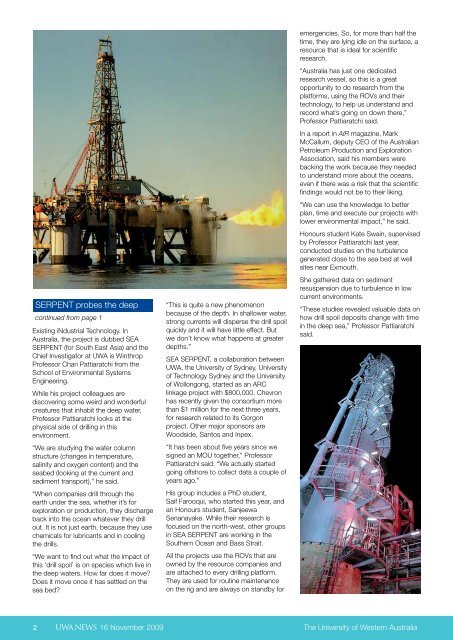
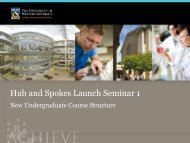

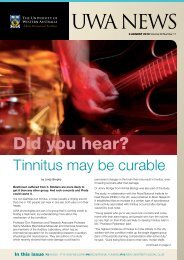





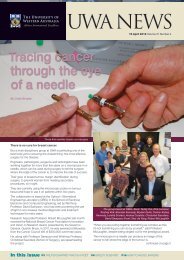
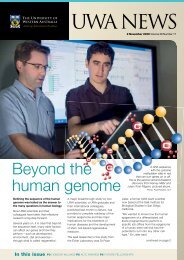
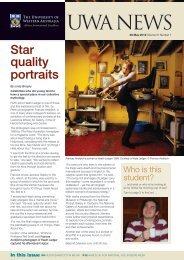


![Issue 13. 6 September 2010.pdf [PDF File, 1.7 MB] - UWA Staff - The ...](https://img.yumpu.com/26619782/1/184x260/issue-13-6-september-2010pdf-pdf-file-17-mb-uwa-staff-the-.jpg?quality=85)